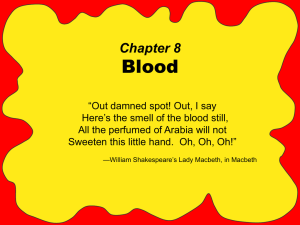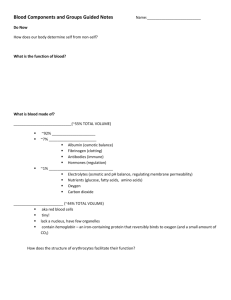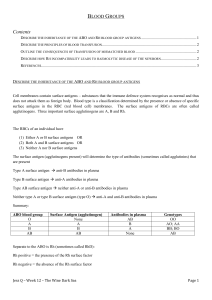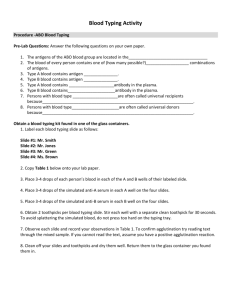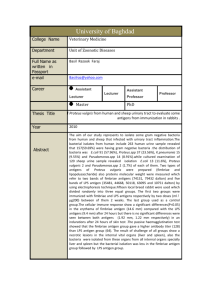Blood Typing Basics
advertisement
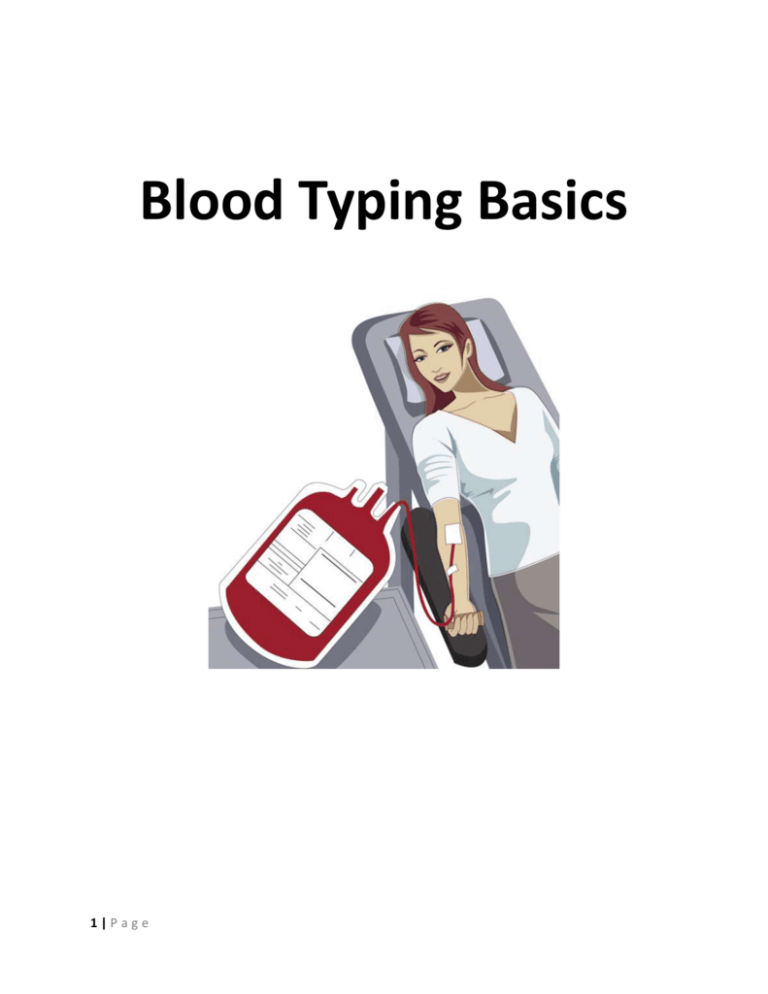
Blood Typing Basics 1|Page BLOOD BANK ANTIGENS AND ANTIBODIES Antigens are defined as substances recognized by the body as foreign, causing the body to produce an antibody to react specifically with it. Antibodies are proteins produced by lymphocytes as a result of stimulation by an antigen which can then interact specifically with that particular antigen. In order a substance to be an antigen to you it must be foreign (not found in the host): Autologous antigens are your own antigens (not foreign to you) Homologous, or allogenic, antigens are antigens from someone else (within the same species) that are foreign to you Blood group antigens: There are over 300 known blood group antigens Over 1,000,000 different antigen sites on each red blood cell. These antigens are attached to proteins or lipids on the red cell membrane and are usually complex sugar groups. Some stick out far on the red cell membrane and some are buried within crypts on the membrane surface. http://faculty.matcmadison.edu/mljensen/BloodBank/lectures/blood_bank_antigens_and_antibodi.htm Rules of Thumb For in vivo Antigen-Antibody Reactions 1. If a person's cell have the antigen, the antibody should NOT be present in that person's serum 2. If an antibody to a blood group antigen is present in the serum of a person, his or her cells should lack that antigen 3. The antigens are on the cells and the antibodies are in the serum Stages of Antigen-Antibody Interaction 2|Page The first stage is sensitization. Sensitization occurs when antibodies react with antigens on the cells and coat the cells The second stage of the reaction is agglutination. Agglutination occurs when antibodies on coated cells form cross-linkages between cells resulting in visible clumping. BACKGROUND PART TWO: BLOOD TYPING BASICS Karl Landsteiner opened the doors for blood banking with his discovery of the first human blood grouping system ABO, now also called ABH. His discovery marked the beginning of the concept of a person’s unique identity based upon the antigens present on the membrane of the erythrocytes (RBC) membrane. In 1901 Landsteiner drew blood from himself and five associates, separated the cells from the serum, and then mixed each cell sample with each serum. He was inadvertently the first person to perform both the forward and reverse grouping. The ABO group contains four blood types: A, B, AB, and O. The letters A and B represent antigens on the red blood cell membranes. A person with type A has A antigen on the RBC's, and someone with type B blood has the B antigen. Type AB means that both A and B antigens are present, and type O means that neither the A nor the B antigen is present. http://pathmicro.med.sc.edu/mayer/rx-7.jpg The frequency of these blood groups is as follows: O positive O negative A positive A negative B positive B negative AB positive AB negative 3|Page 38% 7% 34% 6% 9% 2% 3% 1% ABO typing: If your blood cells stick together when mixed with: (Uses patient’s whole blood or RBC’s and antisera) Anti-A serum, you have type A blood Anti-B serum, you have type B blood Both anti-A and anti-B serums, you have type AB blood If your blood cells do not stick together when anti-A and anti-B are added, you have type O blood. Reverse typing or back typing: (uses the patient’s serum and type A cells and/or type B Cells from whole blood. http://i.dailymail.co.uk/i/pix/2008/06/21/article-1028274-01A7982200000578-632_468x344_popup.jpg If the blood clumps together only when B cells are added to your sample, you have type A blood. If the blood clumps together only when A cells are added to your sample, you have type B blood. If the blood clumps together when either types of cells are added to your sample, you have type O blood. Lack of blood cells sticking together when your sample is mixed with both types of blood indicates you have type AB blood. Source of Blood Typing antisera: Monoclonal antibodies react with very specific antigenic determinants. They are not produced in humans or animals, but harvested from cells in cells grown in tissue culture. The tissue culture cells made from fusion of a plasma cell, which is the antibody producer and the myeloma cell, which provides longevity and ability to make large amounts of antibody Lectins are sugar-binding proteins that are highly specific for their sugar recognition affinities. They play a role in biological recognition phenomena involving cells and proteins. Purified lectins are important in a clinical setting because they are used for identifying some of the ABO(H) antigens. Some of the, (the prefix gyco refers to the presence of sugars) glycolipids and glycoproteins on an individual's red blood cells can be identified by lectins. Lectins (a.k.a. toxalbumins, phytotoxins, or phytohemagglutinins) were originally discovered in plants more than a century ago by their ability to agglutinate (clot together) human red blood cells (erthyrocytes). Some lectins are so specific in agglutinating certain blood types that they were used in the characterizations of the human blood groups A, B, and O. The lectin is composed of amino acids, and these proteins bind to sugar molecules of glycoproteins attached to the 4|Page outside of blood cells, but they can also bind to glycoproteins on other cell types and to simple sugars alone, such as sucrose. A lectin from Dolichos biflorus, (the Hyacinth bean), is used to identify cells that belong to the A1 blood group. A lectin from Ulex europaeus, (spiny evergreen shrubs) is used to identify the H blood group antigen. A lectin from Vicia graminea, (broad beans and vetch), is used to identify the N blood group antigen. RH typing: If your blood cells stick together when mixed with anti-Rh serum, you have type Rhpositive blood. If your blood does not clot when mixed with anti-Rh serum, you have type Rh-negative blood. Blood types are based on specific antigens and antibodies related to RBC's. Specific blood type antigens called agglutinogens are found in the cell membrane of erythrocytes. Antibodies called agglutinins are in the plasma and are formed after birth. When agglutinins in the plasma combine with agglutinogens on the surface of the RBC the result is agglutination or clumping of the RBC's. The agglutinogens on the red blood cells are organized into groups. Although 30 groups are recognized, the ABO and the Rh are the most important. Blood type antigens on the surface of the RBC's are agglutinogens. The antibodies in the plasma are called agglutinins. The ABO grouping system is the only blood group system in which individuals will have antibodies in their serum to antigens that are absent from their RBC. This occurs without any exposure to RBC’s by transfusion or pregnancy. Due to the presence of these antibodies transfusion of an incompatible ABO type can result in almost immediate lysis, (disintegration), of the donor RBC’s. This produces a very severe, if not immediately fatal, transfusion reaction in the patient. 5|Page A patient's red blood cells can be mixed with antibody to a blood group antigen to determine a person's blood type. In a second example, a patient's serum is mixed with red blood cells of a known blood type to assay for the presence of antibodies to that blood type in the patient's serum. INHERITANCE OF BLOOD ANTIGENS The theory for inheritance of the ABO blood groups was first described by Bernstein in 1924. He demonstrated that an individual inherits one ABO gene from each parent and these two genes determine which ABO antigens are present on the membrane of the red blood cells, (RBC’s). The ABO system like other blood systems is co-dominant in expression. One position or locus on each chromosome 9 is occupied by an A, B, or O gene. In case of O allele, the exon 6, (the sixth piece of active DNA in that chromosome) contains a deletion that results in a loss of enzymatic activity. The deletion causes a frameshift and results in translation of an almost entirely different protein that lacks enzymatic activity. This results in “H” antigen remaining unchanged in case of O groups. So the O gene is considered an amorph (present but not functional) because no antigen is produced in responsehttp://www.kinghawk828.com/en/up_files/xuexing1.jpg to the inheritance of this gene. The formation of the blood antigens results from the interaction of genes at three separate loci, (ABO, Hh and Se). These genes do not actually code for production of antigens, but for the production of specific enzymes which add sugars to a basic precursor substance that is common to all of the blood types. A, B, and H antigens develop as early as the 37th day of fetal life. The RBC’s of the newborn have 25% to 50% fewer antigenic sites that those present on adult RBC’s and the complete complement of these antigens will not develop until 2-4 years of age. The H gene also located on chromosome 9 is inherited by persons of all blood types and codes for the production of an enzyme that catalyzes the attachment of sugars to the RBC’s cell membrane in response to the A and B genes inherited as a part of another locus on chromosome 9. So if a person lacks the H substance even if they have inherited the A and B genes it will appear that they have type O blood because the sugars that are synthesized and attached to the basic precursor substance will not be present and a blood test will indicate that the person has type O blood (Bombay Phenotype). The “H” gene is present in 99.9 % of the random population. The allelic combination of “Hh” is quite rare and “hh” is exceptionally rare with an inheritance rate of 1/8,000 in Taiwan, 6|Page 1/10,000 in India and 1/1,000,000,000 in Europe and the U.S. A patient who inherits the hh combination of genes lacks the normal expression of any of the ABH antigens. ABH antigens are an integral part of the membranes of RBC’s, endothelial cells,(The endothelium is the thin layer of cells that line the interior surface of blood vessels, forming an interface between circulating blood in the lumen and the rest of the vessel wall. Endothelial cells line the entire circulatory system, from the heart to the smallest capillary), platelets, responsible for blood clotting), lymphocytes,(white blood cells), and epithelial cells, (cover and line body surfaces). ABH soluble antigens can also be found in all body secretions. Their presence is dependent on the ABO genes inherited as well as the inheritance of another set of genes on chromosome 9 called the secretor genes (Se or se). Eighty percent of the U.S. populations are known as secretors because they have inherited one of the secretor genes. The inheritance of the Se gene coded for the production of the A, B, and H antigens only in bodily secretions and does not affect the production of ABH antigens on the RBC”s themselves. The term “secretor” refers to the presence of A, B, and H substances in the body fluids, and the presence of these substances does confirm the inheritance of an A, B, H, and Se gene in an individual. In order to be a non-secretor the selected A, B, and H antigens are absent because a person has inherited two copies of the “se” gene If a person is a secretor soluble A , B, and H antigens will be present in sweat, tears, saliva, and serum. When a blood test is performed on a patient there are actually two separate test one uses antiserum to test for the presence of the antigens on the surface of the RBC’s and a separate test to determine the presence of the antigens in the serum. Not all blood type antigens are inherited as a part of chromosome number 9. The “Rh” antigen also called antigen “D” is inherited as a gene on chromosome number one. The inheritance of this gene is considered by hematologists to be the most statistically significant of the 30 blood antigens with the exception of the A, B, and H antigens. Antigen D is present if 85% of the random population while 15% of the population lacks the “D” antigen. In 1939 Philip Levine and Rufus E. Stetson published their findings about a family who had a stillborn baby who died of hemolytic disease of the newborn. The mother was aged 25 and it was her second pregnancy and she suffered blood loss at the delivery. Both parents were blood group O and the husband's blood was used to give the mother a blood transfusion, but the mother suffered a severe transfusion reaction. They investigated this transfusion reaction. Since the mother and the father were both blood group O, they concluded that there must be a previously undiscovered blood group antigen that was present on the husband's RBCs but was not present on the mother's RBCs and that the mother had formed antibodies against the new blood group antigen. This suggested for the first time that a mother could make blood group antibodies because of immune sensitization to her fetus's RBCs. They did not name this blood group antigen, but it was subsequently found to be the Rhesus factor. Additional genes near the “Rh” locus are the C, c, and E, e genes that are thought to help regulate the expression the “Rh” antigens on the surface of RBC’s, and all must be tested to determine the patients “Rh” phenotype. 7|Page MEDICAL CONDITIONS RELATED TO SECRETED BLOOD TYPE ANTIGENS o If a person is a secretor, the presence of the blood antigens will influence the populations of bacteria capable of taking up residence in the gastro-intestinal tract. This occurs because some of the bacteria in the GI tract are capable of producing enzymes that allow them to degrade the terminal sugar of the A, B, and H antigens and consume them as a food supply. o ABH secretors have longer blood clotting times because they lack the necessary concentrations of clotting factors o Significant variations in carbohydrate concentrations in breast milk are found between secretors and non-secretors. o ABH non-secretors have a significantly higher number of duodenal and peptic ulcers o ABH non-secretors are at a higher risk for urinary tract infections o ABH non-secretors are at higher risk for Neisseria meningitis o ABH non-secretors are at higher risk for Candida albicans infections o ABH non-secretors have a higher risk of dental caries SO BLOOD TYPE CAN BE DETERMINED BASED ON THE PRESENCE OR ABSENCE OF ANTIGENS AND ANTIBODIES IN WHOLE BLOOD, SERUM OR OTHER BODY FLUIDS AND SOME TISSUES. 8|Page THE CASE OF THE MISSING COLLEGE STUDENTS: Aaron and Rebekah decided late on Wednesday night to take a weekend trip to Crossville, TN to one of their favorite parks for a camping trip. They needed to relax before their final exams began. Little did they know this would be the longest trip they would ever take. Aaron and Rebekah were experience hikers and rafters in the Blue Ridge Mountains and had worked several summers in Cumberland Mountain State Park that was just a few miles east of Nashville. The pair left the Vanderbilt campus early on Thursday morning with plans to return late the following Sunday. They were up early and eager to get started. They stopped at the convenience store across from Rebekah’s apartment to pick up last minute supplies and were seen on the store’s security tapes at 4:35 a.m. smiling and holding hands. They had decided not to call friends to tell them about the last minute trip, it was early and they had all been up late studying. When neither Rebekah nor Aaron was in class on Monday their friends were not too concerned because it was not unusual for the pair to skip Monday classes. When neither of the two was in classes all week, Rebekah’s roommate decided to call the police to report the couple missing. The authorities began an immediate search. This is when the police discovered the convenience store video tape and they discovered a second video of the pair in Aaron’s SUV at a freeway onramp for I 40 East. The timestamp on this video was 5:45 a.m. and corresponded with the time that the couple had been seen at the store. The interviews with the couple’s friends painted a picture of a happy couple who enjoyed spending their free time together sharing their passion for hiking and camping. The police searched both of the student’s apartments and discovered that their camping gear was missing. In subsequent interview authorities discovered that the area where Rebekah and Aaron liked to camp was difficult mountainous terrain, with a thick dense canopy of trees, dense undergrowth, and numerous deep valleys and gorges. Aarons SUV was discovered by park rangers in a remote area behind Byrd Lake in the Cumberland Mountain State Park. After a lengthy and extensive search, the couple was never found. More than a year later a group of hikers discovered two sets of remains near an unused trail at the bottom of a deep gorge. The remains were in an advanced state of decomposition. There was some soft tissue still intact, but it was decomposed to the point where ethnicity and gender were not immediately identifiable. There were no clothes on the remains. The pelvis of each skeleton was absent, the long bones were scattered and had obviously been gnawed on by scavengers, and the marrow had been exposed to the elements. There were obvious signs of foul play because only a few fragments of each skull were located Because of the lack of evidence, determination of gender will be difficult. The long bones were used to estimate height of each of each of the sets of remains. Set two is estimated to be approximately 6’2” and set number one is estimated to be 5’6”. These height estimations are consistent with the heights of Rebekah and Aaron. The ethnicity of the remains was judged 9|Page to be Caucasian based on the lack of curvature in each of the femoral shafts, which is also consistent with the missing couple. Based on this preliminary information, Police believed that the remains might be those of the two missing students. But you must complete the analysis of the tissue samples in order for the police to make a positive ID. Police are sure foul play is involved in the case because remains of clothing were not located and the condition of the skull fragments indicated blunt force trauma. There were also injuries on the femurs of both victims that had been made with a wide sharp blade and that were inconsistent with the activity of predators. Tissue samples were obtained and sent to you for analysis. Due to the advanced state of decomposition, cyto-technicians have fixed some of the samples for you onto slides so that you can more quickly complete your portion of the investigation. Aaron’s blood type is AB and Rebekah’[s blood type is O 10 | P a g e


